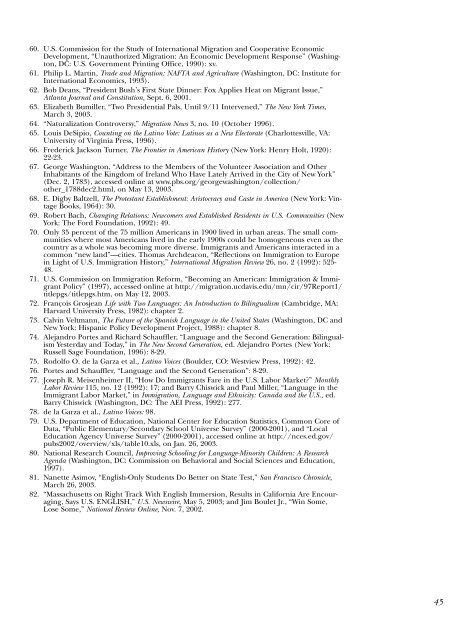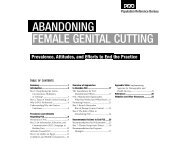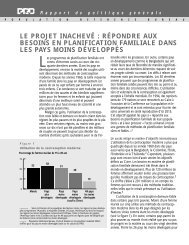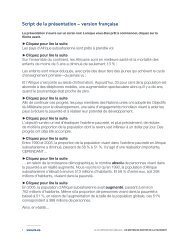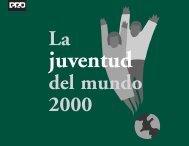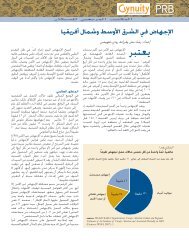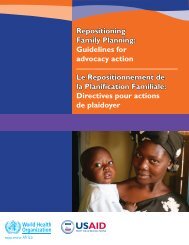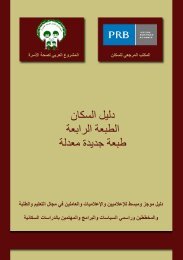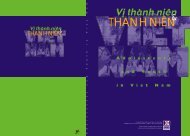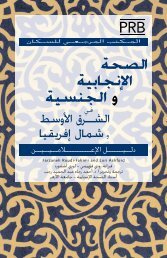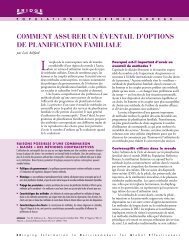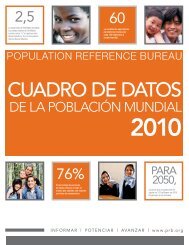Immigration Shaping America - Population Reference Bureau
Immigration Shaping America - Population Reference Bureau
Immigration Shaping America - Population Reference Bureau
You also want an ePaper? Increase the reach of your titles
YUMPU automatically turns print PDFs into web optimized ePapers that Google loves.
60. U.S. Commission for the Study of International Migration and Cooperative Economic<br />
Development, “Unauthorized Migration: An Economic Development Response” (Washington,<br />
DC: U.S. Government Printing Office, 1990): xv.<br />
61. Philip L. Martin, Trade and Migration: NAFTA and Agriculture (Washington, DC: Institute for<br />
International Economics, 1993).<br />
62. Bob Deans, “President Bush’s First State Dinner: Fox Applies Heat on Migrant Issue,”<br />
Atlanta Journal and Constitution, Sept. 6, 2001.<br />
63. Elizabeth Bumiller, “Two Presidential Pals, Until 9/11 Intervened,” The New York Times,<br />
March 3, 2003.<br />
64. “Naturalization Controversy,” Migration News 3, no. 10 (October 1996).<br />
65. Louis DeSipio, Counting on the Latino Vote: Latinos as a New Electorate (Charlottesville, VA:<br />
University of Virginia Press, 1996).<br />
66. Frederick Jackson Turner, The Frontier in <strong>America</strong>n History (New York: Henry Holt, 1920):<br />
22-23.<br />
67. George Washington, “Address to the Members of the Volunteer Association and Other<br />
Inhabitants of the Kingdom of Ireland Who Have Lately Arrived in the City of New York”<br />
(Dec. 2, 1783), accessed online at www.pbs.org/georgewashington/collection/<br />
other_1788dec2.html, on May 13, 2003.<br />
68. E. Digby Baltzell, The Protestant Establishment: Aristocracy and Caste in <strong>America</strong> (New York: Vintage<br />
Books, 1964): 30.<br />
69. Robert Bach, Changing Relations: Newcomers and Established Residents in U.S. Communities (New<br />
York: The Ford Foundation, 1992): 49.<br />
70. Only 35 percent of the 75 million <strong>America</strong>ns in 1900 lived in urban areas. The small communities<br />
where most <strong>America</strong>ns lived in the early 1900s could be homogeneous even as the<br />
country as a whole was becoming more diverse. Immigrants and <strong>America</strong>ns interacted in a<br />
common “new land”—cities. Thomas Archdeacon, “Reflections on <strong>Immigration</strong> to Europe<br />
in Light of U.S. <strong>Immigration</strong> History,” International Migration Review 26, no. 2 (1992): 525-<br />
48.<br />
71. U.S. Commission on <strong>Immigration</strong> Reform, “Becoming an <strong>America</strong>n: <strong>Immigration</strong> & Immigrant<br />
Policy” (1997), accessed online at http://migration.ucdavis.edu/mn/cir/97Report1/<br />
titlepgs/titlepgs.htm, on May 12, 2003.<br />
72. François Grosjean Life with Two Languages: An Introduction to Bilingualism (Cambridge, MA:<br />
Harvard University Press, 1982): chapter 2.<br />
73. Calvin Veltmann, The Future of the Spanish Language in the United States (Washington, DC and<br />
New York: Hispanic Policy Development Project, 1988): chapter 8.<br />
74. Alejandro Portes and Richard Schauffler, “Language and the Second Generation: Bilingualism<br />
Yesterday and Today,” in The New Second Generation, ed. Alejandro Portes (New York:<br />
Russell Sage Foundation, 1996): 8-29.<br />
75. Rodolfo O. de la Garza et al., Latino Voices (Boulder, CO: Westview Press, 1992): 42.<br />
76. Portes and Schauffler, “Language and the Second Generation”: 8-29.<br />
77. Joseph R. Meisenheimer II, “How Do Immigrants Fare in the U.S. Labor Market?” Monthly<br />
Labor Review 115, no. 12 (1992): 17; and Barry Chiswick and Paul Miller, “Language in the<br />
Immigrant Labor Market,” in <strong>Immigration</strong>, Language and Ethnicity: Canada and the U.S., ed.<br />
Barry Chiswick (Washington, DC: The AEI Press, 1992): 277.<br />
78. de la Garza et al., Latino Voices: 98.<br />
79. U.S. Department of Education, National Center for Education Statistics, Common Core of<br />
Data, “Public Elementary/Secondary School Universe Survey” (2000-2001), and “Local<br />
Education Agency Universe Survey” (2000-2001), accessed online at http://nces.ed.gov/<br />
pubs2002/overview/xls/table10.xls, on Jan. 26, 2003.<br />
80. National Research Council, Improving Schooling for Language-Minority Children: A Research<br />
Agenda (Washington, DC: Commission on Behavioral and Social Sciences and Education,<br />
1997).<br />
81. Nanette Asimov, “English-Only Students Do Better on State Test,” San Francisco Chronicle,<br />
March 26, 2003.<br />
82. “Massachusetts on Right Track With English Immersion, Results in California Are Encouraging,<br />
Says U.S. ENGLISH,” U.S. Newswire, May 5, 2003; and Jim Boulet Jr., “Win Some,<br />
Lose Some,” National Review Online, Nov. 7, 2002.<br />
45


